Calossa and I
As an artist Hanni Stolker is mainly occupied with painting colourful, mostly figurative work, in which the skin often plays a role. She also sings the song of life, but that can also be Brecht or Kurt Weill. In 1997 she signed up for three months' Callosa, which she visited in early 1998. It would be the first of many trips to Calossa.

I was actually farting butts. "If it's not fun, you can go home again"; I had said to myself. The opposite happened. After three months I was in the plane, crying, because I didn't really want to go back to the Netherlands. Callosa d'en Sarrià is a town with 10,000 inhabitants on top of a mountain, situated between Valencia and Alicante, and behind Benidorm, the Costa Blanca. It is almost always good weather, a microclimate. The Fundatie Knecht-Drenth (FKD) has four houses that can be rented for one or more months by Dutch and/or Belgian artists and/or scientists. The houses are casas antiquasold houses, up in the village. A lot of wind and a steep climb. Narrow alleys with houses in which the donkeys used to sleep. Pedestrians have priority over cars. In many places you can see the sea. I am a hardworking artist, but also like to be among people. Cheerfulness and a drink are well spent for me. If you go on the street in Callosa, you are already among the people. There is life on the streets. And everyone is very friendly. The FKD expects you to be present as well as occupied with your work. What you do, you have to know and organise yourself.
Gradually more and more Spanish influences crept into the gouaches.
In 1998 I had planned to make gouaches to illustrate the songs I was singing. Gradually, more and more Spanish influences crept into those gouaches. I also made drawings about Spanish songs. These works were exhibited afterwards in Arnhem. A Dutch woman asked me to paint the walls around her swimming pool in Moraira. Sirenasmermaids, they were. And in Altea a kitchen studio asked me to make a mural.
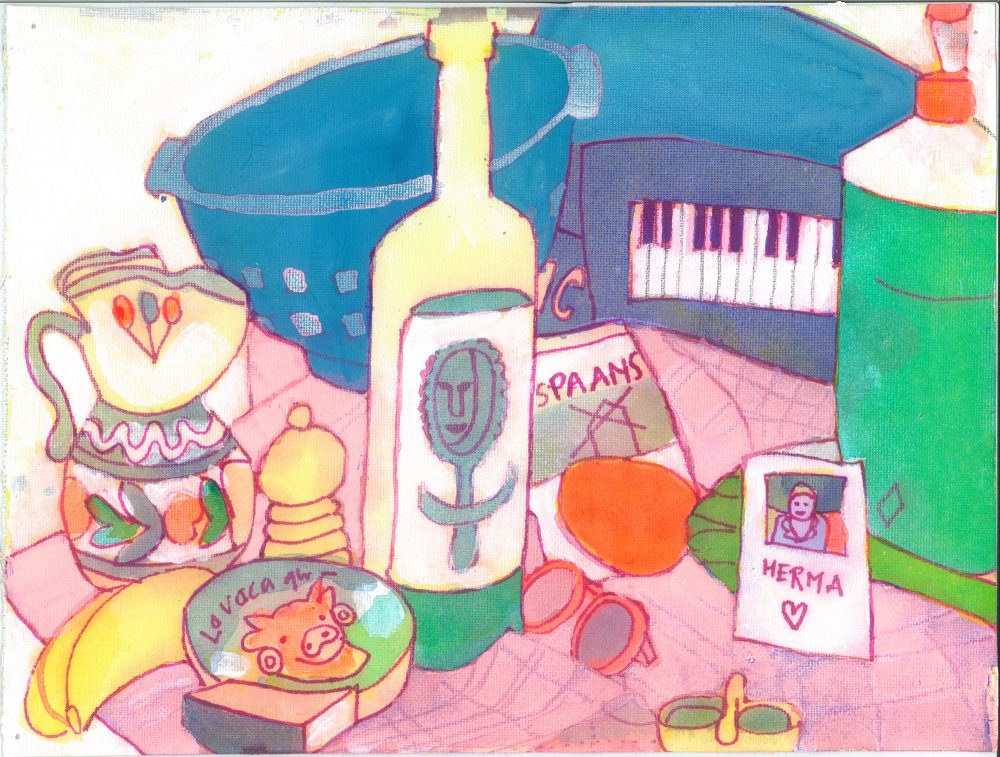 In Calossa, the foreigners can all take free Spanish lessons in the Casa de Cultura. Belgians, Romanians, Norwegians, Brazilians and English. There, in the Casa de CulturaI heard a choir with an orchestra-- rondalla) sing the songs I've always been so curious about: Habaneras! I was enchanted. I asked the soloist of the choir, Rosa Savall, to teach me the songs and I was asked to sing with the choir. I am very tall and stand head and shoulders above the other singers, so that it seems that they are sitting and I am standing. Every time I came to Calossa after that, I was immediately told on the street that I was expected at the choir rehearsal. In the meantime, I have completely mastered the Spanish-language song repertoire. Chavela Vargas, María Dolores Pradera and José Alfredo Jimenez are my heroes. In the Netherlands I have performed with these songs and made performances.
In Calossa, the foreigners can all take free Spanish lessons in the Casa de Cultura. Belgians, Romanians, Norwegians, Brazilians and English. There, in the Casa de CulturaI heard a choir with an orchestra-- rondalla) sing the songs I've always been so curious about: Habaneras! I was enchanted. I asked the soloist of the choir, Rosa Savall, to teach me the songs and I was asked to sing with the choir. I am very tall and stand head and shoulders above the other singers, so that it seems that they are sitting and I am standing. Every time I came to Calossa after that, I was immediately told on the street that I was expected at the choir rehearsal. In the meantime, I have completely mastered the Spanish-language song repertoire. Chavela Vargas, María Dolores Pradera and José Alfredo Jimenez are my heroes. In the Netherlands I have performed with these songs and made performances.
The windows of the seven bakers as an exhibition spot!
When I was back in Calossa in 2004 I thought about something I could do that would be visible to everyone in the village. Whenever there is a death in Calossa, you can hear it from the church bells, which then ring a sad melody. Then A-4's with text and a photo of the deceased are stuck on the windows of the bakeries. The windows of the seven bakers as an exhibition spot! I wanted to talk about the imminent marriage of Prince Felipe with newsreader Letizia Ortiz. I went to the bakers with a note written in Spanish. Could I draw pictures on the windows of their bakeries using coloured tape? Si, si, si! The exhibit was called: Panaderias reales, royal bakeries. It was a success with a beautiful opening. The choir came to sing, the bakers provided tapas, the media were present.
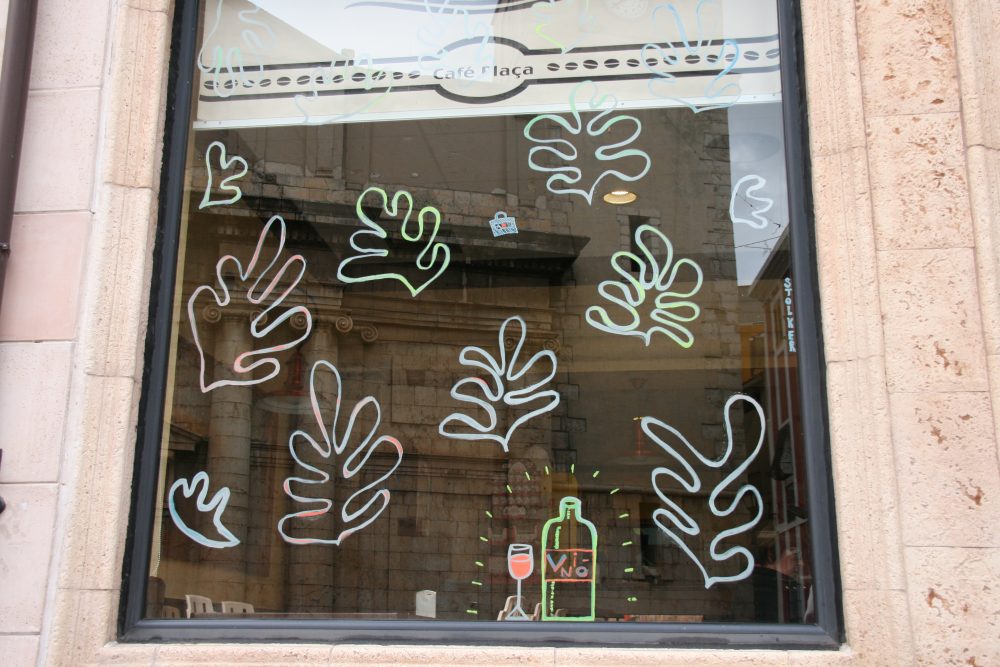 Another year I made painted portraits of a number of villagers. I also made drawings on shop windows with liquid chalk. I was able to achieve this through the chairman of the shopkeepers' association, Vicente Savall. Plastic bags had just been banned at the time, so the shopkeepers' association brought reusable bags into circulation. I was asked to make drawings on the windows to introduce the bag. I made figures of the Moors and Christians on the occasion of the big local annual celebrations. These were very suitable for the shop windows.
Another year I made painted portraits of a number of villagers. I also made drawings on shop windows with liquid chalk. I was able to achieve this through the chairman of the shopkeepers' association, Vicente Savall. Plastic bags had just been banned at the time, so the shopkeepers' association brought reusable bags into circulation. I was asked to make drawings on the windows to introduce the bag. I made figures of the Moors and Christians on the occasion of the big local annual celebrations. These were very suitable for the shop windows.
I also drew David of Michelangelo with a bag of the shopkeeper's association in his hand. In bars, shops, the town hall I made drawings on the inside of the windows. When I was outside the town hall, the emergency serviceswas watching me work, I almost got picked up by the policía local. They thought I was defacing city hall.
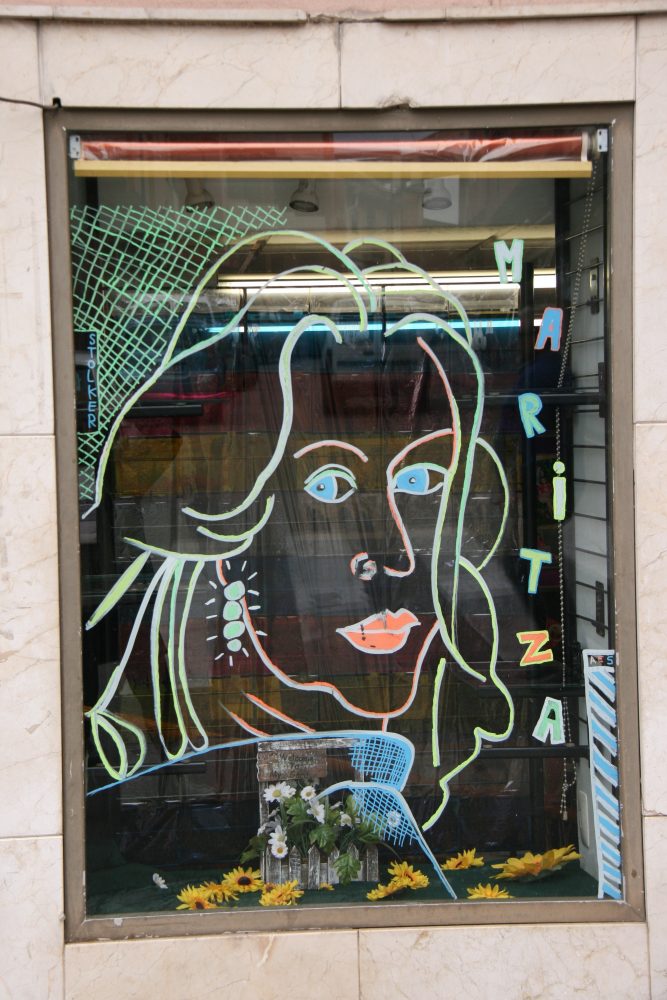 Last year I had the alcalde (Mayor) of Callosa, Pep Savall (another Savall, all family, once you live in Callosa you never leave) arranged that I would make a mural in the village. This would be about the local fruit the nispero. The expensive nisperos replace the oranges that no longer bring in anything, only 45 cents a kilo. Cheap oranges are imported from South Africa. Because a permit did not come in time, this year, 2019, I was supposed to have the nispero-mural mural. However, when I arrived in Callosa on January 2, 2019, a major scandal was just underway. The alcalde was always in the national media.
Last year I had the alcalde (Mayor) of Callosa, Pep Savall (another Savall, all family, once you live in Callosa you never leave) arranged that I would make a mural in the village. This would be about the local fruit the nispero. The expensive nisperos replace the oranges that no longer bring in anything, only 45 cents a kilo. Cheap oranges are imported from South Africa. Because a permit did not come in time, this year, 2019, I was supposed to have the nispero-mural mural. However, when I arrived in Callosa on January 2, 2019, a major scandal was just underway. The alcalde was always in the national media.
That's not like our deaf Pep.
I didn't mention the mural again. Instead I put a 'Spanish' still life in my studio, which I wanted to tackle in every possible way. The cleaning ladies (limpiadoras) of the FKD mistook it for a pile of rubbish, cleaned it up and threw it away. Of course I made a new still life and continued working. I had wanted to exhibit all the works in my little house and give a party and sell some as well, but the (Spanish?) flu disrupted my plans. It raged this year. I was really sick. For the first time.
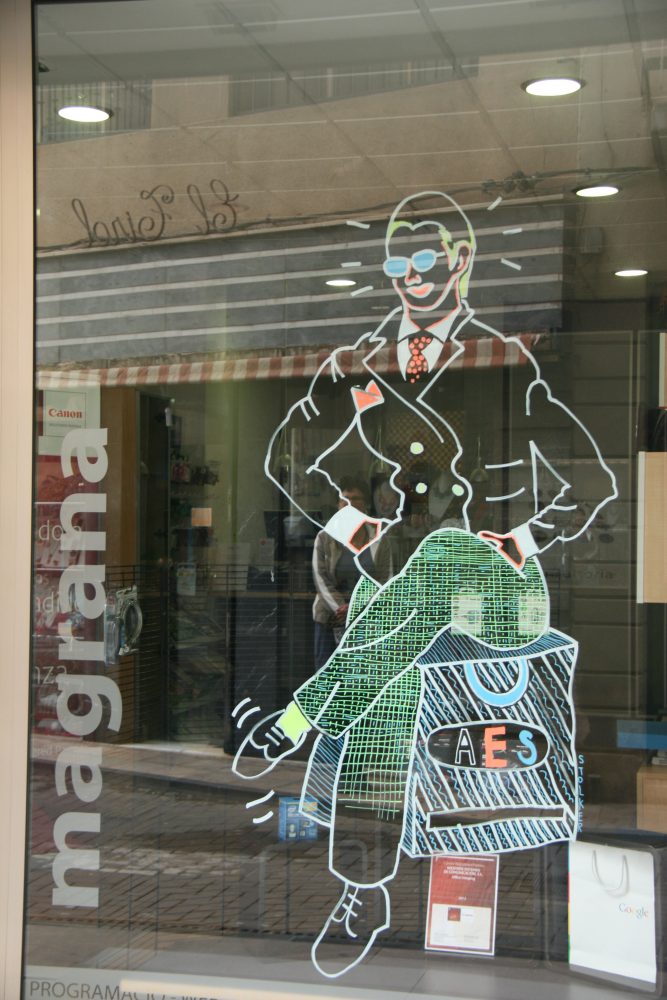 In the buildings of the FKD that surround me there is work going on as well, of course. Because I prefer to speak Spanish when I'm there, I try to avoid Dutch people. Speaking Dutch is too easy, 1000 times easier than speaking Spanish. For me. Spanish, contrary to what many people claim, is not an easy language. It is a beautiful language and opens a gate to a great rich culture. That's how I really experienced it myself. Unfortunately for me, the people in Callosa are very nationalistic, and speak a different language than the Spanish we know and learn. They speak Valencian. This is similar to Catalan and is very ugly and unintelligible. In the house of the FKD opposite me this year there were two writers from Amsterdam. They sat behind their laptops all day.
In the buildings of the FKD that surround me there is work going on as well, of course. Because I prefer to speak Spanish when I'm there, I try to avoid Dutch people. Speaking Dutch is too easy, 1000 times easier than speaking Spanish. For me. Spanish, contrary to what many people claim, is not an easy language. It is a beautiful language and opens a gate to a great rich culture. That's how I really experienced it myself. Unfortunately for me, the people in Callosa are very nationalistic, and speak a different language than the Spanish we know and learn. They speak Valencian. This is similar to Catalan and is very ugly and unintelligible. In the house of the FKD opposite me this year there were two writers from Amsterdam. They sat behind their laptops all day.
Highlights of my stays in Callosa are the performances with the rondalla that I always participate in when I'm there. We also perform in other cities. After the concerts there are always tables with tapas and mistella And it's party time! Last year I was allowed to join the procession on Good Friday. With such a capucho (pointed hat) where you only have holes for the eyes. It was terrifying, because you can't see a thing and you can hardly breathe. For me it was a great honor. And great to see the devotion of the many spectators without being spied upon.
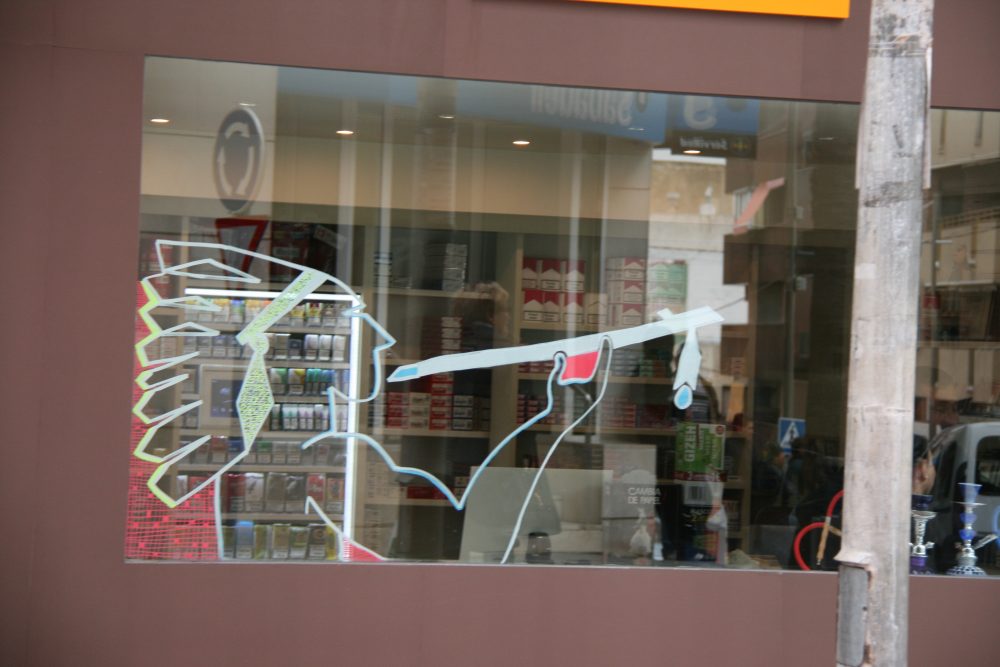 The daytrips to Valencia with Spanish colleague Joan Llobell are great too. There are four (!) museums for modern art in Valencia: Carme, IVAM, Banxia and Bombas Gens Centre d'Art. It's hard work to see them all in one day. Back in the Netherlands I immediately signed up for the FKD again, for 2020. It's never certain whether they can place you, because newcomers come first.
The daytrips to Valencia with Spanish colleague Joan Llobell are great too. There are four (!) museums for modern art in Valencia: Carme, IVAM, Banxia and Bombas Gens Centre d'Art. It's hard work to see them all in one day. Back in the Netherlands I immediately signed up for the FKD again, for 2020. It's never certain whether they can place you, because newcomers come first.


